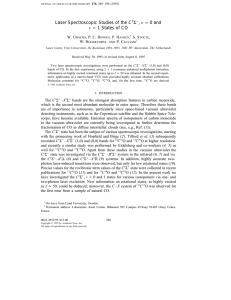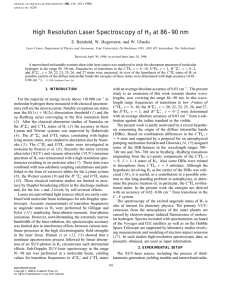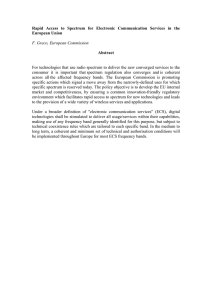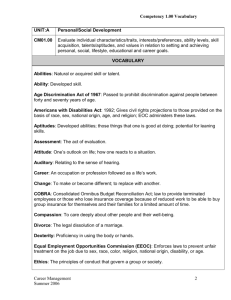n
advertisement
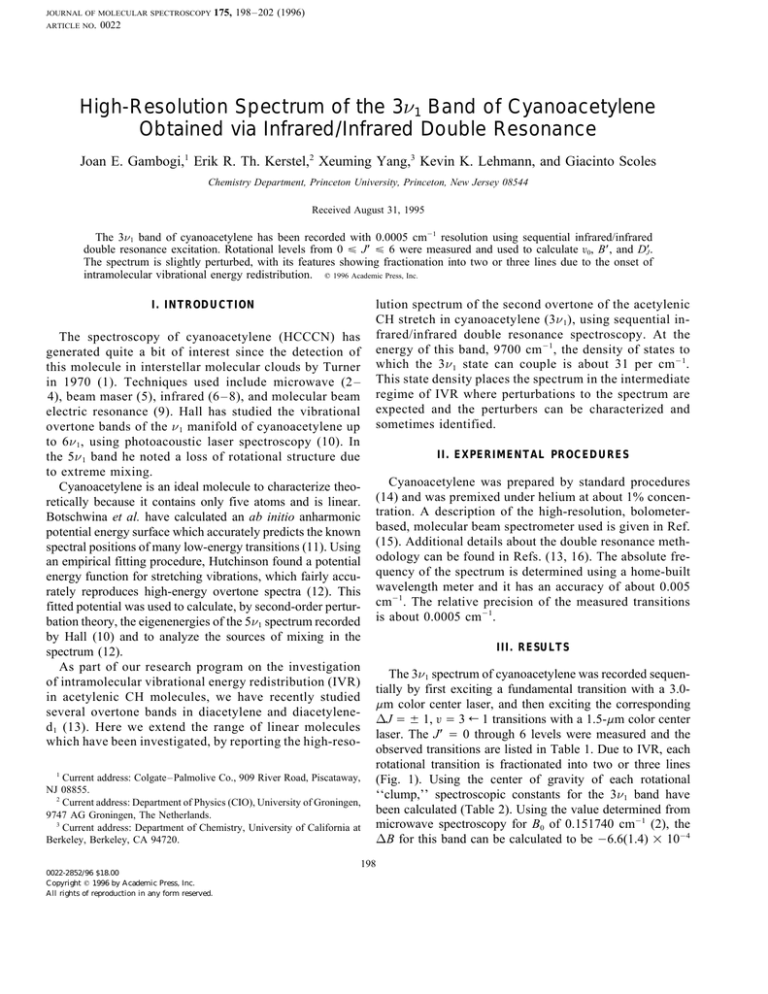
JOURNAL OF MOLECULAR SPECTROSCOPY
ARTICLE NO.
175, 198–202 (1996)
0022
High-Resolution Spectrum of the 3n1 Band of Cyanoacetylene
Obtained via Infrared/Infrared Double Resonance
Joan E. Gambogi,1 Erik R. Th. Kerstel,2 Xeuming Yang,3 Kevin K. Lehmann, and Giacinto Scoles
Chemistry Department, Princeton University, Princeton, New Jersey 08544
Received August 31, 1995
The 3n1 band of cyanoacetylene has been recorded with 0.0005 cm01 resolution using sequential infrared/infrared
double resonance excitation. Rotational levels from 0 £ J* £ 6 were measured and used to calculate £0, B*, and DJ*.
The spectrum is slightly perturbed, with its features showing fractionation into two or three lines due to the onset of
intramolecular vibrational energy redistribution. q 1996 Academic Press, Inc.
I. INTRODUCTION
The spectroscopy of cyanoacetylene (HCCCN) has
generated quite a bit of interest since the detection of
this molecule in interstellar molecular clouds by Turner
in 1970 (1). Techniques used include microwave (2 –
4), beam maser (5), infrared (6 – 8), and molecular beam
electric resonance (9). Hall has studied the vibrational
overtone bands of the n1 manifold of cyanoacetylene up
to 6n1, using photoacoustic laser spectroscopy (10). In
the 5n 1 band he noted a loss of rotational structure due
to extreme mixing.
Cyanoacetylene is an ideal molecule to characterize theoretically because it contains only five atoms and is linear.
Botschwina et al. have calculated an ab initio anharmonic
potential energy surface which accurately predicts the known
spectral positions of many low-energy transitions (11). Using
an empirical fitting procedure, Hutchinson found a potential
energy function for stretching vibrations, which fairly accurately reproduces high-energy overtone spectra (12). This
fitted potential was used to calculate, by second-order perturbation theory, the eigenenergies of the 5n1 spectrum recorded
by Hall (10) and to analyze the sources of mixing in the
spectrum (12).
As part of our research program on the investigation
of intramolecular vibrational energy redistribution (IVR)
in acetylenic CH molecules, we have recently studied
several overtone bands in diacetylene and diacetylened1 (13). Here we extend the range of linear molecules
which have been investigated, by reporting the high-reso1
Current address: Colgate–Palmolive Co., 909 River Road, Piscataway,
NJ 08855.
2
Current address: Department of Physics (CIO), University of Groningen,
9747 AG Groningen, The Netherlands.
3
Current address: Department of Chemistry, University of California at
Berkeley, Berkeley, CA 94720.
lution spectrum of the second overtone of the acetylenic
CH stretch in cyanoacetylene (3n1), using sequential infrared/infrared double resonance spectroscopy. At the
energy of this band, 9700 cm01, the density of states to
which the 3n1 state can couple is about 31 per cm 01.
This state density places the spectrum in the intermediate
regime of IVR where perturbations to the spectrum are
expected and the perturbers can be characterized and
sometimes identified.
II. EXPERIMENTAL PROCEDURES
Cyanoacetylene was prepared by standard procedures
(14) and was premixed under helium at about 1% concentration. A description of the high-resolution, bolometerbased, molecular beam spectrometer used is given in Ref.
(15). Additional details about the double resonance methodology can be found in Refs. (13, 16). The absolute frequency of the spectrum is determined using a home-built
wavelength meter and it has an accuracy of about 0.005
cm01. The relative precision of the measured transitions
is about 0.0005 cm01.
III. RESULTS
The 3n1 spectrum of cyanoacetylene was recorded sequentially by first exciting a fundamental transition with a 3.0mm color center laser, and then exciting the corresponding
DJ Å { 1, £ Å 3 R 1 transitions with a 1.5-mm color center
laser. The J* Å 0 through 6 levels were measured and the
observed transitions are listed in Table 1. Due to IVR, each
rotational transition is fractionated into two or three lines
(Fig. 1). Using the center of gravity of each rotational
‘‘clump,’’ spectroscopic constants for the 3n1 band have
been calculated (Table 2). Using the value determined from
microwave spectroscopy for B0 of 0.151740 cm01 (2), the
DB for this band can be calculated to be 06.6(1.4) 1 1004
198
0022-2852/96 $18.00
Copyright q 1996 by Academic Press, Inc.
All rights of reproduction in any form reserved.
AID
JMS 6901
/
m4652$$$48
01-23-96 16:29:10
mspa
AP: Mol Spec
THE 3n1 BAND OF CYANOACETYLENE
TABLE 1
Summary of Observed Transitions (£ Å 1 r 3 Step)
* The wavenumbers for the 0 r 1 transitions are from Ref. (6): R(0)
3327.680 cm01, R(1) 3327.978 cm01, R(2) 3328.277 cm01, R(3) 3328.577
cm01, R(5) 3329.187 cm01, and R(6) 3329.489 cm01.
cm01. This is in reasonable progression with the DB’s for
n1 and 2n1 of 02.45 1 1004 and 04.72 1 1004 cm01, respectively (6). The value of D*J determined from the fit is two
orders of magnitude larger than the ground state centrifugal
distortion constant. This can be taken as an indication of
one or more near-resonant spectral perturbations which tune
as a function of J*.
Qualitatively the spectrum indicates the presence of two
different types of perturbations. At J* Å 0 the spectrum
is dominated by a single feature. At J* Å 1 the strong line
is split into two almost equal components while at J* Å
2 the second component is much weaker and by J* Å 3
there is again only one strong line. At J* Å 4 the stronger
feature splits again. This rapid appearance and disappearance of perturbing states indicates that they are close in
energy but weakly coupled to the 3n1 bright state. The
two perturbations, one observed at J* Å 1, the other at
J* Å 4, are most likely unrelated. Since each of these
perturbations is observed over only two J states, there is
not enough information for an accurate identification. A
modified (17) Lawrance – Knight deconvolution (18) was
used to deperturb the spectrum and yield the energies of
the perturbing states and their coupling strengths to the
bright state. Using the deperturbed energies, a fit was
attempted in order to estimate the rotational constant of
these two weak perturbers. The results are listed in Table
3. For the perturbation at J* Å 1 and 2, the 1 r 3 transitions
of P(2), P(3), and R(1) were used in the fit; at J* Å 4 and
5, R(3), P(6), and R(4) were used. The DB’s determined
from the fit (01.77(78) 1 1003 and 01.23(40) 1 1003
cm01, i.e., 053 and 037 MHz) are significantly larger
(more negative) than that of the bright state. This is an
indication that the perturbing states contain a significant
amount of stretching character.
At each of the J* measured there is also present a less
intense line, about 0.06 cm01 higher in energy. Since this
perturbation is present in all the rotational clumps, it indicates a state that is relatively far away from and more
strongly coupled to the bright state. The coupling strength
for this less intense line averaged over all the rotational
levels observed is 0.016 cm01. The coupling strengths for
the two perturbing states mentioned above are an order
of magnitude smaller and have the values 0.0016, 0.0025,
0.0013, and 0.00054 cm 01 for J* Å 1, 2, 4, and 5, respectively. The results of a fit to determine the spectroscopic
constants of this strongly coupled state (after deperturbation) are listed in Table 4. The DB for this state, 01.3
(4.0) 1 1004 cm01 (04 MHz), is smaller than that for the
bright state, indicating some bending character (/DB) in
the perturber.
The density of S/ states around 9667 cm01 is 31 per cm01.
This was calculated by a direct count, constraining the total
vibrational angular momentum to zero. The normal modes
Copyright q 1996 by Academic Press, Inc.
AID
JMS 6901
/
m4652$$$49
01-23-96 16:29:10
199
mspa
AP: Mol Spec
200
GAMBOGI ET AL.
FIG. 1. Portions of the 3n1 band of cyanoacetylene recorded using sequential infrared/infrared double resonance. The frequency scale represents the
frequency of the scanning laser.
and anharmonicities listed in Ref. (6) were used. Figure 2
shows a histogram of the DB’s for all the states calculated
to be between 9617 and 9717 cm01. The vibration–rotation
interaction constants, ai’s, used in the calculation were ob-
tained from Ref. (10). The mean DB is /152 MHz, indicating that the strongly coupled perturber, with a DB of 04
MHz, is considerably different than the average and does
not contain a statistical mixture of all possible perturbing
TABLE 2
Spectroscopic Constants of the 3n1 Band Determined from a Fit of the Center of
Gravities (cm01)a
a
Lower state constants were constrained to the values determined in Ref. (6) for the n1 band:
£0 Å 3327.372 cm01, B1 Å 0.15149569 cm01, and D1 Å 1.77 1 1008 cm01. The value for B0 was
determined from microwave spectroscopy to be 0.151740 cm01 (Ref. 2).
b
Error reported in parentheses represents 2s of the fit.
Copyright q 1996 by Academic Press, Inc.
AID
JMS 6901
/
m4652$$$49
01-23-96 16:29:10
mspa
AP: Mol Spec
THE 3n1 BAND OF CYANOACETYLENE
TABLE 3
Spectroscopic Constants for the Two Deperturbed Weakly Coupled (Low-Frequency)
Eigenstates of the 3n1 Band (cm01)a
a
Lower state constants and DJ* were constrained to the values determined in Ref. (6) for the n1
band: £0 Å 3327.372 cm01, B1 Å 0.151496 cm01, and D1 Å 1.77 1 1008 cm01. The value for B0
was determined from microwave spectroscopy to be 0.151740 cm01 (Ref. 2).
b
Error reported in parentheses represents 2s of the fit.
TABLE 4
Spectroscopic Constants for the Deperturbed Strongly Coupled (High-Frequency)
Eigenstate of the 3n1 Band (cm01)a
a
Lower state constants were constrained to the values determined in Ref. (6) for the n1 band:
£0 Å 3327.372 cm01, B1 Å 0.15149569 cm01, and D1 Å 1.77 1 1008 cm01. The value for B0 was
determined from microwave spectroscopy to be 0.151740 cm01 (Ref. 2).
b
Error reported in parentheses represents 2s of the fit.
Copyright q 1996 by Academic Press, Inc.
AID
JMS 6901
/
m4652$6901
01-23-96 16:29:10
mspa
AP: Mol Spec
201
202
GAMBOGI ET AL.
IV. CONCLUSIONS
The 3n1 band of cyanoacetylene, with a calculated density
of states of 31 per cm01, shows a spectrum characteristic of
the onset of IVR. There is evidence in the spectrum of two
weak perturbations that only appear briefly and a strong
perturbation that is present at each rotational transition. This
high-resolution spectrum, together with other spectroscopic
studies of cyanoacetylene, makes this molecule a good testing ground for theoretical studies such as that done by Hutchinson (12).
REFERENCES
FIG. 2. Histogram of rotational constants of the vibrational states between 9617 and 9717 cm01.
modes. In spite of knowing the a’s and many anharmonicities for the normal modes of cyanoacetylene, there are still
too many states nearby in energy to attempt a definitive
analysis of the perturber. If we limit the energy region to
{10 cm01 and the DB to {10 MHz, there are 28 S states.The
average number of quanta in this set of states is 12.7, compared to 19.4 quanta for all states within 100 cm01. One
state out of the 28 possibilities that is a particularly close
match with the observed perturbing state has a calculated
energy of 9666.9 cm01 and a DB equal to 03.3 MHz. This
state is made up of n2 / n3 / n4 / 4 n5 / 4 n6 vibrations,
where n2, n3 and n4 are stretching vibrations and n5 and n6
are bending vibrations.
1. B. E. Turner, Astrophys. J. Lett. 163, L35–L39 (1971).
2. R. A. Creswell, G. Winnewisser, and M. C. L. Gerry, J. Mol. Spectrosc.
65, 420–429 (1977).
3. P. D. Mallinson and R. L. de Zafra, Mol. Phys. 36, 827–843 (1978).
4. K. T. Yamada and R. A. Creswell, J. Mol. Spectrosc. 116, 384–405
(1986).
5. R. L. de Zafra, Astrophys. J. 170, 165–168 (1971).
6. P. D. Mallinson and A. Fayt, Mol. Phys. 32, 473–485 (1976).
7. K. Yamada, R. Schieder, G. Winnewisser, and A. W. Mantz, Z. Naturforsch. A 35, 690–693 (1980).
8. K. Yamada, R. Best, and G. Winnewisser, Z. Naturforsch. A 38, 1296–
1308 (1984).
9. R. L. DeLeon and J. S. Muenter, J. Chem. Phys. 82, 1702–1704 (1985).
10. R. R. Hall, Ph.D. Dissertation, Rice University, 1984.
11. P. Botschwina, M. Horn, S. Seeger, and J. Flugge, Mol. Phys. 78, 191–
198 (1993).
12. J. S. Hutchinson, J. Chem. Phys. 82, 22–30 (1985).
13. J. E. Gambogi, R. Z. Pearson, X. Yang, K. K. Lehmann, and G. Scoles,
Chem. Phys. 190, 191–205 (1995).
14. F. A. Miller and D. H. Lemmon, Spectrochim. Acta Part A 23, 1415–
1423 (1967).
15. E. R. Th. Kerstel, K. K. Lehmann, T. F. Mentel, B. H. Pate, and G.
Scoles, J. Phys. Chem. 95, 8282–8293 (1991).
16. J. E. Gambogi, E. R. Th. Kerstel, K. K. Lehmann, and G. Scoles, J.
Chem. Phys. 100, 2612–2622 (1994).
17. K. K. Lehmann, J. Phys. Chem. 95, 7556–7557 (1991).
18. W. D. Lawrance and A. E. W. Knight, J. Phys. Chem. 89, 917–925
(1985).
Copyright q 1996 by Academic Press, Inc.
AID
JMS 6901
/
m4652$$$49
01-23-96 16:29:10
mspa
AP: Mol Spec


